 In Edwidge’s story, Junior is trapped under his pancaked house for 8 whole days. After he is saved, people ask him repeatedly: “What did you do all this time? Were you scared? Did you cry?””I played,” he answers. And so with each page, we see how he played in his mind every day he was trapped–how he played marbles with his friends, won the best solo part in the choir, biked through St. Marc with his little sister, and ate the sweetest mango.Hope, love, and warmth dance across each page, reminding us that sometimes it is the simplest beauties that help us find our strength.Niki, the real boy whom this story is loosely based on, was pulled from the rubble after being trapped for 8 days. He was rescued by New York Task Force 1, a search-and-rescue team made up of New York City police- and firemen. They had to cut through three slabs of concrete and countless other pieces of debris before his mother could crawl in to coax Niki and his sister out. When he finally made it out of the wreckage, Niki did so with a beaming smile and wide-open arms–the image of hope.** The photograph taken of Niki by Mathew McDermott as they pulled him from the wreckage is being called “the iconic image” of this disaster. We are embracing its visibililty by using an illustration echoing the photograph for the cover of the book and printing the photograph in the back matter.** In addition, this project is charity driven. Both Edwidge and Alix are donating a portion of their advances to Haitian aid organizations. Scholastic and their vendors are contributing portions of their costs for the production of this book.
In Edwidge’s story, Junior is trapped under his pancaked house for 8 whole days. After he is saved, people ask him repeatedly: “What did you do all this time? Were you scared? Did you cry?””I played,” he answers. And so with each page, we see how he played in his mind every day he was trapped–how he played marbles with his friends, won the best solo part in the choir, biked through St. Marc with his little sister, and ate the sweetest mango.Hope, love, and warmth dance across each page, reminding us that sometimes it is the simplest beauties that help us find our strength.Niki, the real boy whom this story is loosely based on, was pulled from the rubble after being trapped for 8 days. He was rescued by New York Task Force 1, a search-and-rescue team made up of New York City police- and firemen. They had to cut through three slabs of concrete and countless other pieces of debris before his mother could crawl in to coax Niki and his sister out. When he finally made it out of the wreckage, Niki did so with a beaming smile and wide-open arms–the image of hope.** The photograph taken of Niki by Mathew McDermott as they pulled him from the wreckage is being called “the iconic image” of this disaster. We are embracing its visibililty by using an illustration echoing the photograph for the cover of the book and printing the photograph in the back matter.** In addition, this project is charity driven. Both Edwidge and Alix are donating a portion of their advances to Haitian aid organizations. Scholastic and their vendors are contributing portions of their costs for the production of this book.
Haiti
Running the Road To ABC
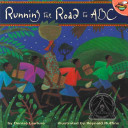
Six island children are running at daybreak — over the hills, through the fields, across the city square — to school! Never before has the love of learning (and learning together) been such a joyous time. Denise Lauture’s buoyant, poetic text captures the happiness and youth of energetic children on the way to school; Reynold Ruffins perfectly illustrates the rich beauty of Haiti with the bright-colored vibrance of Haitian folk art.
Hope For Haiti
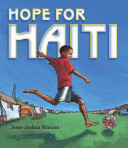
A young boy finds hope when he is given an old soccer ball to play with in the wake of Haiti’s devastating earthquake.
Selavi: A Haitian Story of Hope
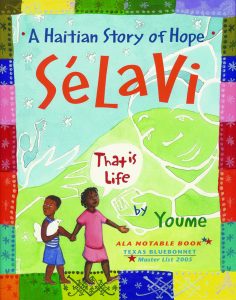 The story of Selavi celebrates the triumphs of children who face some of life’s most difficult challenges. In these pages, you’ll meet Selavi, a homeless child who is befriended by other children living on the streets in Haiti. They look out for one another, sharing food and companionship. Together they find the voice to express the needs of Timoun Lari, the children who live in the streets. With a caring community they are able to build a shelter, and from there to create Radyo Timoun, Children’s Radio, a station run by and for children, which is still in operation today. At Radyo Timoun, the questions and suggestions of children are broadcast for all to hear. The story takes place in Port-Au-Prince, Haiti, a country which has a long history of resistance and struggle. Haiti is the birthplace of Toussaint L’ouverture and many others whose dedication to justice led to Haitian independence from slaveowners. Haiti is perhaps best known as the island which orchestrated the first successful revolt by enslaved peoples in the western hemisphere in 1804. Haitian author Edwidge Danticat adds an essay at the end of the story of Selavi.
The story of Selavi celebrates the triumphs of children who face some of life’s most difficult challenges. In these pages, you’ll meet Selavi, a homeless child who is befriended by other children living on the streets in Haiti. They look out for one another, sharing food and companionship. Together they find the voice to express the needs of Timoun Lari, the children who live in the streets. With a caring community they are able to build a shelter, and from there to create Radyo Timoun, Children’s Radio, a station run by and for children, which is still in operation today. At Radyo Timoun, the questions and suggestions of children are broadcast for all to hear. The story takes place in Port-Au-Prince, Haiti, a country which has a long history of resistance and struggle. Haiti is the birthplace of Toussaint L’ouverture and many others whose dedication to justice led to Haitian independence from slaveowners. Haiti is perhaps best known as the island which orchestrated the first successful revolt by enslaved peoples in the western hemisphere in 1804. Haitian author Edwidge Danticat adds an essay at the end of the story of Selavi.
This book has been included in WOW’s Kids Taking Action Booklist. For our current list, visit our Boolist page under Resources in the green navigation bar.
Featured in Volume I, Issue 2 of WOW Review.
Please, Malese! A Trickster Tale from Haiti
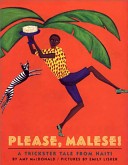
Without a penny to his name, Malese takes advantage of his neighbors using his tricky ways, until they catch on, after which he manages to pull an even bigger trick on them.
Open The Door To Liberty
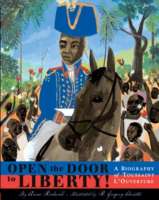
The story of revolution leader Toussaint L’Ouverture of St. Domingue (now Haiti).The island now known as Haiti was once a French colony called St. Domingue, where white plantation owners forced hundreds of thousands of African slaves to farm sugar cane. Toussaint L’Ouverture was one of those slaves . . . but not for long. The day would come when L’Ouverture would lead his island’s slaves into a revolution for freedom, and his efforts would influence the course of world history.
Josias, Hold the Book

Every Morning Josias is hard at work in the family’s garden under the hot Haitian sun. And every morning he sees his friend Chrislove walk to school. When will you join us to hold the book? asks Chrislove. But Josias has a garden to tend and no time to learn to read and write, especially now that the garden is failing. Josias can’t figure out why the beans aren’t growing. Without beans, there may not be enough food for his family. He tries giving the beans more water. He tries working more fertilizer into the soil. Still, the garden shows no sign of life. One morning, when Chrislove asks again when his friend plans to come to school, Josias wonders if a book might hold the solution to his problem.
Featured in Volume I, Issue 2 of WOW Review.
Touching Snow

‘”The best way to avoid being picked on by high school bullies is to kill someone.\”Karina has plenty to worry about on the last day of seventh grade: finding three Ds and a C on her report card again, getting laughed at by everyone again, being sent to the principal — again. She\’d like this to change, but with her and her sisters dodging their stepfather\’s fists every day after school, she doesn\’t have time to do much self-reflecting. Finally her stepfather is taken away on child abuse charges, and Karina thinks things might turn into something resembling normal. The problem is, he\’s not gone for good. And as Karina becomes closer with a girl at the community center where her stepfather is not showing up for his parenting classes, she starts to realize a couple things. First, for all the problems her family had tried to escape by immigrating from Haiti, they brought most of them along to upstate New York. And second, if anything is going to change for this family, it is going to be up to Karina and her sisters to make it happen.M. Sindy Felin\’s debut novel is the story of a young girl\’s coming-of-age amid the violent waters that run just beneath the surface of suburbia — a story that has the courage to ask: How far will you go to protect the ones you love?
Haiti (Cultures of the World)
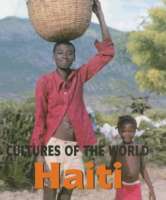
“Explores the geography, history, government, economy, people, and culture of Haiti.”–Provided by publisher.
Teenage Refugees from Haiti Speak Out (In Their Own Voices)
These books begin with historical overviews of Haiti, including the reasons for recent political unrest. The first-person narratives of young refugees follow. All of the teens tell why they left their native countries, how they made their journeys, their experiences and difficulties in North America, and if they plan to return to their homelands. The introductions state that the young people were interviewed; it is unclear exactly when these conversations took place. It seems in Haiti as if they occurred prior to the reinstatement of President Aristide.
